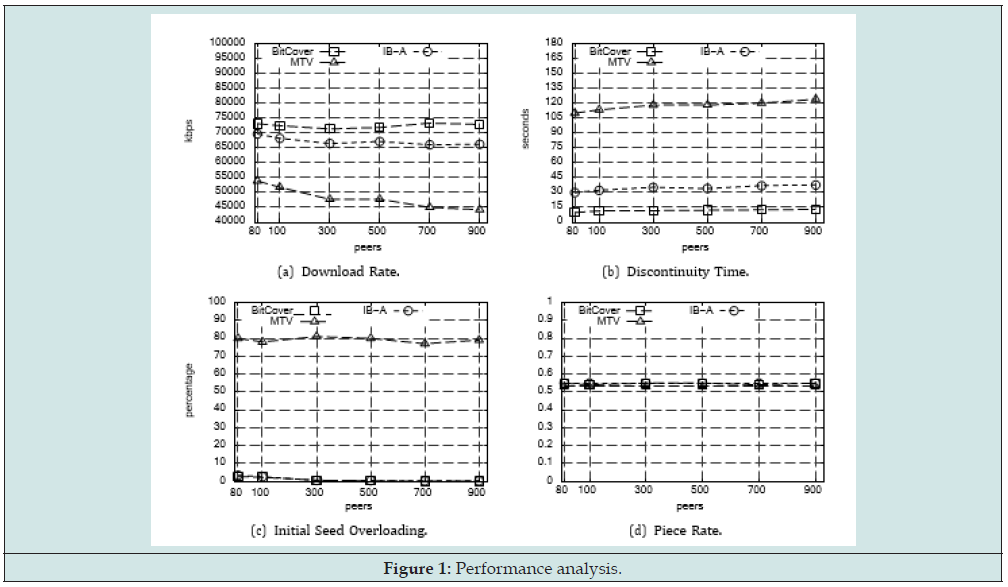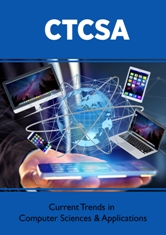
Lupine Publishers Group
Lupine Publishers
Menu
ISSN: 2643-6744
Review articleOpen Access
How Effective is the Bittorrent Paradigm for Vod Streaming Over 5G Wireless Networks? Volume 2 - Issue 3
Carlo Kleber da Silva Rodrigues* and Vladimir Rocha
- Federal University of ABC, Center for Mathematics, Computation and Cognition Santo André, Brazil
Received: December 21, 2022; Published: January 25, 2023
*Corresponding author:Carlo Kleber da Silva Rodrigues, Federal University of ABC, Center for Mathematics, Computation and Cognition Santo André, SP, Brazil
DOI: 10.32474/CTCSA.2023.02.000140
Abstract
This article aims to assess the effectiveness of the BitTorrent paradigm for VoD streaming over 5G wireless networks. To this end, we look into recent literature works concerning this research theme. The experiments are carried out through simulations assessing a set of important metrics. The major findings indicate that this paradigm may help to optimize the traffic load within each cell site and consequently, best leverage the full potential of 5G communication. Therefore, our main contribution is to provide the literature with valuable subsidies for developing streaming protocols focused on wireless communication. Index Terms-Streaming, BitTorrent, 5G, Wireless.
Introduction
High-performance backhauling systems for the radio access network are pivotal for achieving the 5G commu- nication’s entire potential. This is because the high traffic load inside each cell site needs to be eventually forwarded to the core network using the backhaul network. The backhaul-network bandwidth capacity may hence become a serious limitation for the 5G communication [1-4]. Specifically related to VoD streaming, one alternative to surpass that limitation is to strive to optimize the bandwidth usage within each cell site of the covered area by deploying an effective bandwidth-sharing algorithm. Thereby, we may pose the following research question: How effective would be a BitTorrent-like algorithm? To respond to the afore mentioned question, we then look into recent literature proposals encompassing the BitTorrent paradigm. More precisely, we analyze the fol- lowing algorithms: BitCover [4], IB-A [5], and MTV [6]. These proposals are recent and hence may enable us to obtain a valuable up-to-date assessment of the BitTorrent paradigm’s effectiveness on 5G wireless networks. The evaluation experiments are carried out through simulations considering a set of important metrics. Within this context, the key contribution of this article is to provide the literature with valuable subsidies for developing streaming protocols focused on wireless communication. The remainder of this article is organized as follows. Section II succinctly reviews the BitCover, IB-A, and MTV proposals. Section III explains the experiment setup. Section IV delves into results and analyses. At last, final conclusions and future work constitute Section V.
Literature Proposals: Bit cover, IB-A, and MTV
Each of the BitCover, IB-A, and MTV proposals consists of two core policies: piece selection and peer selection. The former is used by a peer to request video pieces from another peer, and the latter is used by a peer to enable another peer to retrieve video pieces from it. The main differences among these proposals may be seen in Table 1.
Experiment Setup
Our experiments consider a network of n mobile peers. This network is deployed on a single 5G cell covering an obstacle-free area of 500 m2. The n peers move according to a SMOOTH mobility model [7]. which mimics real human movements. The value of n never changes, i.e., when a peer leaves, another one is automatically added to the network. The n peers want to watch a common video and may perform interactivity actions during the video playback. We give further details related to our experiments in the subsections to follow.
a) Interactivity and Video Type: Regarding interactivity actions, peers can execute the following ones: Play, Pause, Jump Forwards, and Jump Backwards. This is the same interactivity model as in the original proposal of BitCover for a user’s highinteractivity profile. The common video consists of a short video lecture of length 37 minutes (2,199 seconds), for a total size of 5,370 MB, encoded at 20,000 kbps bitrate.
b) Data Transmission and Delay: The peer’s total bandwidth capacity is 100 Mbps for 5G technology, and 250 Mbps for WiFi Direct. The data transmission can suffer delays and losses. For the WiFi- Direct connection, we use Friis’s path loss formula to compute the signal strength between two peers. The delay and packet loss are then calculated using the distance between them, the packet size, and the signal strength. For the 5G connection, we use a delay between 5 and 20 ms besides a packet loss probability of 4% as in [1,2].
c) Simulation Model and Metrics: Our experiments are implemented in the PeerSim [8] simulation environment. The hardware platform is an Intel Core i7 (2.6 GHz), 24 GB of RAM, running a GNU/Linux operating system. Table 2 has the four-performance metrics assessed in the experiments. They may together yield evidence of system QoS and client QoE. The computed results have 95% confidence intervals that are within 5% of the reported values, for a total of 30 simulation runs.
Results and Analyses
We outline that our experiments are mainly inspired by those already shown in the original proposal of BitCover. The main difference is that we now call attention to results under a different analysis view. The DR, DT, SO, and PR metrics are depicted in Figure 1 in function of n. From this figure, we get to the observations that follow.
a) All three proposals show adequate numeric values regarding the chosen metrics [9]. Thereby, they may all be deployed in real VoD streaming scenarios.
b) The BitCover proposal outperforms the two other ones at the DR, DT, SO, and PR metrics.
c) The IB-A proposal deserves attention due to its simple
d) implementation. One implementation point is worthy of note: the delivered pieces are stored on interme- diary peers connecting two route endpoints.
e) Under the MTV algorithm, WiFi-Direct channels allow for offloading the backhaul-network traffic. Besides, the centralized streaming server plays an important role by sending pieces directly to peers via 5G when no peers (via WiFi-Direct) can satisfy requests.
f) BitCover also makes use of WiFi-Direct channels to offload the backhaul-network traffic, but it does not deploy a centralized streaming server as MTV. One implementation point is worthy of note: the coverage criterion optimizes the network communication- channel usage.
Final Conclusions and Future Work
Focusing on multimedia streaming, this article analyzed the effectiveness of deploying the BitTorrent paradigm in 5G wireless networks. We did this by examining three recent literature proposals: BitCover, IB-A, and MTV. The experiments were based on simulations that evaluated a set of important metrics in multimedia streaming scenar- ios characterized by different network sizes. From the experiments, we concluded that the BitTorrent paradigm may play a pivotal role in bandwidth usage optimization within each 5G cell site and, consequently, help to leverage the potential of the 5G technology to grant a high-quality video-streaming service. As an extension of this work, we especially consider conducting real measurements in order to ratify or rectify the simulation results obtained herein, besides possibly proposing other BitTorrentbased algorithmic solutions.
References
- D Xu, Anfu Zhou, Xinyu Zhang, Guiana Wang, Xi Liu, et al. (2020) Understanding Operational 5G: A First Measurement Study on Its Coverage, Performance and Energy Consumption, in Proceedings of the Annual Conference of the ACM Special Interest Group on Data Communication on the Applications, Technologies, Architectures, and Protocols for Computer Communication pp. 479-494.
- A Narayanan, Jason Carpenter, Qingxu Liu, Yu Liu, Feng Qian, et al. (2020) A First Look at Commercial 5G Performance on Smartphones, in Proceedings of The Web Conference pp. 894-905.
- L Shrama, A Javali, SK Routray (2020) An Overview of High-Speed Streaming in 5G, in 2020 International Conference on Inventive Computation Technologies (ICICT) pp. 557-562.
- V Rocha and C K da S Rodrigues (2023) Bitcover: Enhanced bittorrent for interactive vod streaming over 5g and wifi-direct, Ad Hoc Networks 140: 103040.
- C K da S Rodrigues and V Rocha (2021) Enhancing BitTorrent for efficient interactive video-on-demand streaming over Journal of Network and Computer Applications 174: 102906.
- Y Yang, X Zhang, and L Zhang (2017) MTV: Mobile Bit Torrent Video Sharing Using Harmonized LTE and WiFi Coexistence, in 2017 IEEE 85th Vehicular Technology Conference (VTC Spring) 1-5.
- A Munjal, T Camp, and W C Navidi (2011) SMOOTH: A Simple Way to Model Human Mobility, in Proceedings of the 14th ACM International Conference on Modeling, Analysis and Simulation of Wireless and Mobile Systems, ser. MSWiM 11: 351-360.
- Montresor and M Jelasity (2009) Peer Sim: A scalable P2P simulator, in IEEE Ninth International Conference on Peer-to-Peer Computing, Washington, USA.
- L Sun, Y Mao, T Zong, Y Liu, and Y Wang (2020) Flocking-Based Live Streaming of 360-Degree Video, in Proceedings of the 11th ACM Multimedia Systems Conference pp. 26-37.

Top Editors
-

Mark E Smith
Bio chemistry
University of Texas Medical Branch, USA -

Lawrence A Presley
Department of Criminal Justice
Liberty University, USA -

Thomas W Miller
Department of Psychiatry
University of Kentucky, USA -

Gjumrakch Aliev
Department of Medicine
Gally International Biomedical Research & Consulting LLC, USA -

Christopher Bryant
Department of Urbanisation and Agricultural
Montreal university, USA -

Robert William Frare
Oral & Maxillofacial Pathology
New York University, USA -

Rudolph Modesto Navari
Gastroenterology and Hepatology
University of Alabama, UK -

Andrew Hague
Department of Medicine
Universities of Bradford, UK -

George Gregory Buttigieg
Maltese College of Obstetrics and Gynaecology, Europe -

Chen-Hsiung Yeh
Oncology
Circulogene Theranostics, England -
.png)
Emilio Bucio-Carrillo
Radiation Chemistry
National University of Mexico, USA -
.jpg)
Casey J Grenier
Analytical Chemistry
Wentworth Institute of Technology, USA -
Hany Atalah
Minimally Invasive Surgery
Mercer University school of Medicine, USA -

Abu-Hussein Muhamad
Pediatric Dentistry
University of Athens , Greece

The annual scholar awards from Lupine Publishers honor a selected number Read More...







